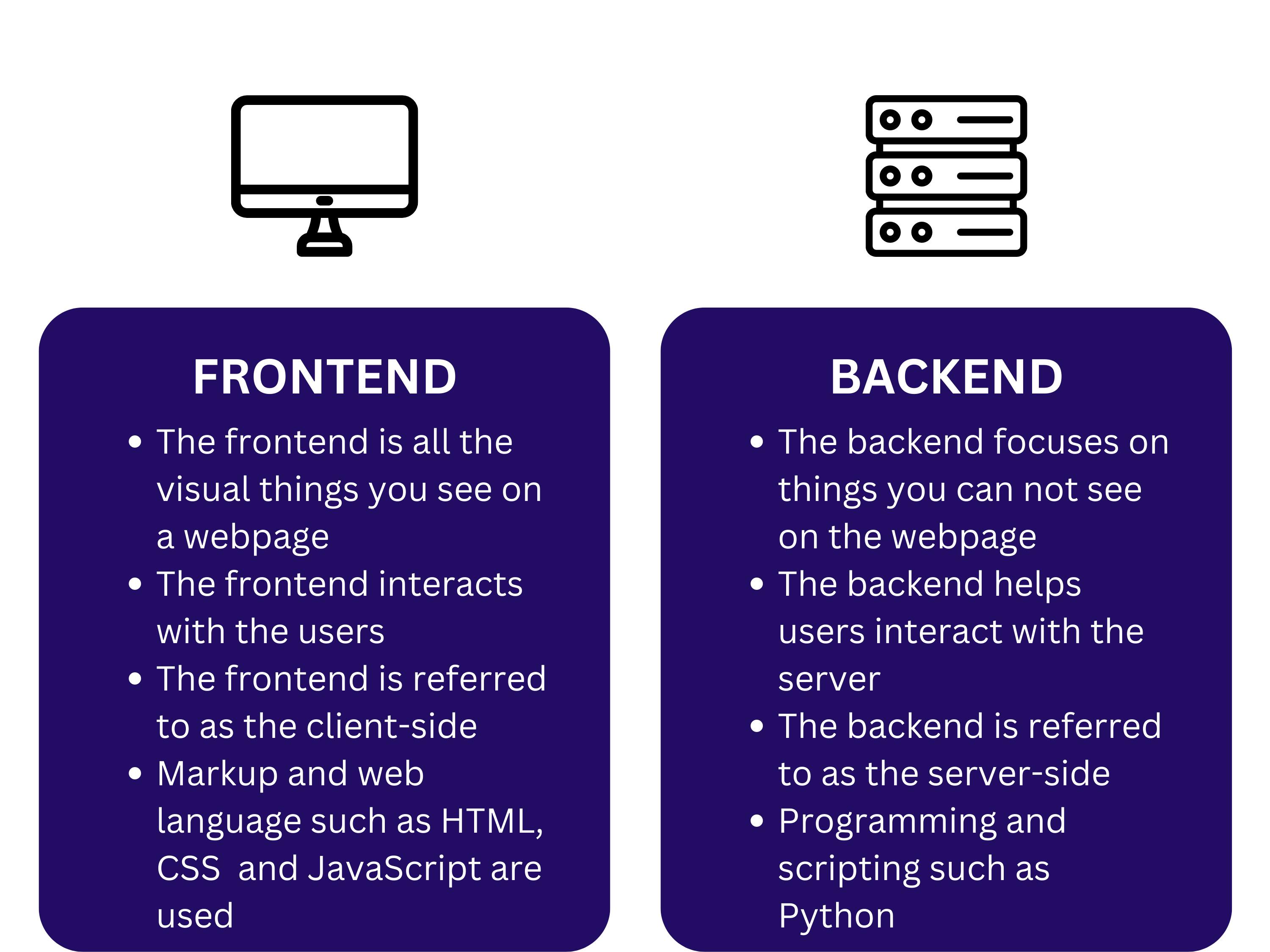Websites and mobile applications are common these days. They are used in various sectors. Behind every pretty website is a combination of technologies that makes it carry out cool and awesome functionalities. Every website can be split into two parts, The front-end and the back-end.
Hello 👋 I am Olivia, a back-end developer, I write in Python and JavaScript. This article is a mimic of my event ‘A Backend Trip with Python’. I will be giving an overview of back-end development in this blog post.
Overview
Back-end development is what keeps the internet running behind the scenes. Back-end developers ensure the website performs correctly, focusing on databases, back-end logic, application programming interface (APIs), architecture, and servers. Users might not be aware of the back-end developer's work, but the website or app won't work without it.
Front-End Development vs Back-End Development

Front-end development and Back-end development are responsible for the internet you interact with all day, every day. Front-end developers use front-end development stack; Back end developers use back-end programming languages to fulfill those requests on the server side. Combined, it creates a seamless experience for the user.
What does a Backend Developer do?
Ever wonder what goes on behind the scenes of a website? Where does your personal information go when you sign up? Or how you are able to successfully login to an account?
Back-end developers are the experts who build and maintain the mechanisms that process data and perform actions on websites. Back-end developers are involved in data storage, security, and other server-side functions that you cannot see.
Responsibilities of a Back-end Developer
The responsibilities of a back-end developer varies in different organizations. In general back-end developers:
- Collaborate with Product Managers, Product Designers and Front-end developers to build and maintain websites
- Working with front-end developers to transfer data efficiently to client-side web applications
- Troubleshoot and debug
- Write high-quality code
Back-end Development Tools
Some common tools for back-end developers include:
- Programming languages:
- Python
- JavaScript
- Ruby
- C#
- Java
- PHP
- Frameworks:
- Laravel
- Django
- Spring
- Ruby on Rails
- Meteor
- Node.js
- Databases:
- MongoDB
- MySQL
- Oracle
- Servers:
- Apache
- NGINX
- Lighttpd
- Microsoft IIS
Technical Skills Required
As a back-end developer you must be conversant with:
- Programming Languages
- Frameworks
- Databases and servers
- Application Program Interface (APIs)
- Accessibility and security clearance:
Soft Skills Required
Technical skills are the first thing an employer looks for in a back-end developer, but knowing how to code isn’t everything. Back-end developers are expected to posses soft skills such as Problem Solving (Back-end developers have to be good problem solvers. They need to be flexible and capable of coming up with creative solutions to issues that arise.) and Communication Skills (collaboration and sharing of ideas are some of the things a back-end developer will come across, excellent communication skills make this seem-less)
Back-end Architecture
 Back-end web architecture is the process of creating the structure and logic of a website's back-end, which includes all the components of a website that aren't visible to users.
Back-end web architecture is the process of creating the structure and logic of a website's back-end, which includes all the components of a website that aren't visible to users.
Here is a list of common components of back-end web architecture:
Servers: A server is a computer that gathers details about the interactions users have with a website, interprets them and sends them across a network. You can program servers to run specific instances of code depending on the inputs they receive. For instance, if a user enters their credit card information on a website, your server may automatically process the payment through a banking application.
Logic: Logic is the sequence of operations that programmers code into the back-end to accomplish specific tasks. Website logic contains algorithms and functions that allow for websites to perform different actions and output information depending on how users behave and interact with website features.
Frameworks: Frameworks are like templates for a website's back-end that software programmers user to facilitate writing and editing code for their server. Some frameworks include data libraries and tools that give programmers access to functional segments of code. For example, a framework may include a tool that allows for easier routing of URLs, which you can paste into your code instead of writing your own custom script.
Databases: Databases contain the information that servers access to direct website functions. In website back-end architecture, databases include information such as integers, characters and arrays, which are sets of variables that have something in common. Databases have many functions that you can use to organize information for users to access.
APIs: APIs, or application programming interfaces, allow software programs to communicate with other servers and databases to exchange information.
Back-end Development Learning/Training Platform
- Tech4Dev
- Zuri
- Ingressive For Good
- Udacity
- Codecademy
- Udemy
- Coursera
Summary
The best way to start your backend development path is to learn a programming or a scripting language: Python, JavaScript, C# and so on. You can engage in self learning or start a training with an organization.
